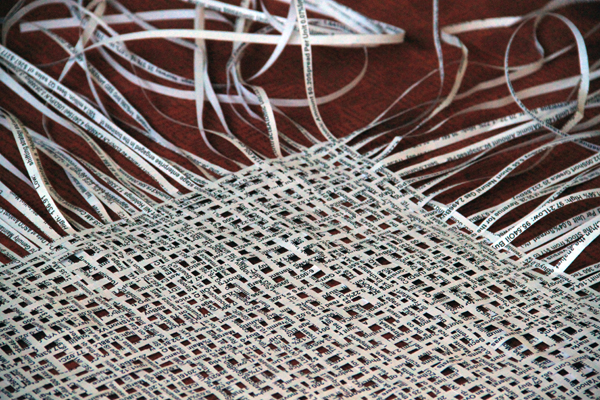War Rug
Praca zrealizowana podczas programu rezydencyjnego
X Harlech Biennale 2012
ICAW Documented Art Space
Transport of Delights
http://www.documentedartspace.co.uk/
War Rug
work produced during Harlech International Artists’ Residency 2012 X Harlech Biennale 2012
ICAW Documented Art Space
Transport of Delights
http://www.documentedartspace.co.uk/

Literally, it is weaved from the stripes of shredded paper with text printed on — to complete that work I collected international stock exchange listings for a period of about three months.
The inspiration comes from the idea of the war rugs recently popular in Afghanistan. (“The rug weavers of Afghanistan, long renowned for their artistry, depict on their rugs the world that they see. Like television news, their rugs “report” current events. Since the Soviet invasion of Afghanistan in 1979 and throughout more than three decades of international and civil war, Afghan weavers have borne witness to disaster by weaving unprecedented images of battle and weaponry into their rugs. Flowers have turned into bullets, landmines, and hand grenades.”)
Like in the case of Afghan carpets I would also like to capture a fragment of time and certain “history”, which has neither the beginning nor the end. That is why the rug is intentionally left unfinished so that someone else could weave it on and add more and more information on the ongoing global market battles.
The rug is, in a way, containing the interlaced, fragmented history. This way it becomes the accumulation of layers of events like in the case of Foucault’s heterotopias.
Malgorzata Szandala, May 2012





War Rug. (Stationary Idea or Directly inaccessible. )
„„Well, I do not say that I get all my ideas by dreaming (…)”
Frederic Jameson Archaeologies of the Future
– Reflections of A.E. Van Vogt, p. 316, published by Verso 2007
Let us re-examine the relation between an artwork and idea behind it.
Let us imagine such a situation:
The idea looses its ephemeral character of a formulated thought and becomes kind of solid and stationary. At the same time the (art) work it represents gains a fluid nature, is variable and not fixed.
Let us take, for instance, the shape of a traffic jam, and look at it closer — as a form it almost always looks the same but the content changes continuously.
According to this, the artwork must be constantly updated, reorganized,
rethought and reshaped. This way the artwork gains the nature of time (while
not being just a time-based artwork).
“The idea behind” may serve as an instruction — always available in the same form and place. The idea represents the definite area where the artwork takes place, whereas the artwork’s substance undergoes the interminable processes
of change.
Let us observe traffic jam, weather conditions, stock exchange listings, up-growth of plants… or just look at clouds and falling rain.
Małgorzta Szandała